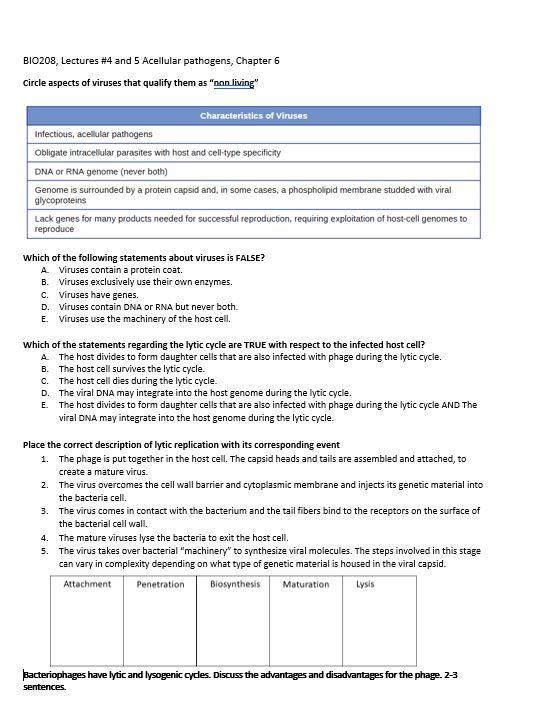Home /
Expert Answers /
Biology /
bio208-lectures-4-and-5-acellular-pathogens-chapter-6-circle-aspects-of-viruses-that-qualify-th-pa558
(Solved): BIO208, Lectures #4 and 5 Acellular pathogens, Chapter 6 Circle aspects of viruses that qualify th ...
BIO208, Lectures #4 and 5 Acellular pathogens, Chapter 6 Circle aspects of viruses that qualify them as "non living" Infectious, acellular pathogens Obligate intracellular parasites with host and cell-type specificity DNA or RNA genome (never both) Genome is surrounded by a protein capsid and, in some cases, a phospholipid membrane studded with viral glycoproteins Lack genes for many products needed for successful reproduction, requiring exploitation of host-cell genomes to reproduce Which of the following statements about viruses is FALSE? A. Viruses contain a protein coat. B. Viruses exclusively use their own enzymes. c. Viruses have genes. D. Viruses contain DNA or RNA but never both. E. Viruses use the machinery of the host cell. Which of the statements regarding the lytic cycle are TRUE with respect to the infected host cell? A. The host divides to form daughter cells that are also infected with phage during the lytic cycle. B. The host cell survives the lytic cycle. C. The host cell dies during the lytic cycle. D. The viral DNA may integrate into the host genome during the lytic cycle. E. The host divides to form daughter cells that are also infected with phage during the lytic cycle AND The viral DNA may integrate into the host genome during the lytic cycle. Place the correct description of lytic replication with its corresponding event 1. The phage is put together in the host cell. The capsid heads and tails are assembled and attached, to create a mature virus. 2. The virus overcomes the cell wall barrier and cytoplasmic membrane and injects its genetic material into the bacteria cell. 3. The virus comes in contact with the bacterium and the tail fibers bind to the receptors on the surface of the bacterial cell wall. 4. The mature viruses lyse the bacteria to exit the host cell. 5. The virus takes over bacterial "machinery" to synthesize viral molecules. The steps involved in this stage can vary in complexity depending on what type of genetic material is housed in the viral capsid. Attachment Penetration Biosynthesis Maturation Lysis Bacteriophages have lytic and lysogenic cycles. Discuss the advantages and disadvantages for the phage. 2-3 sentences. Characteristics of Viruses
Expert Answer
Answer.1 Viruses are non living organisms because they cannot grow independently, they don't have any kind of genetic machinary by which they can replicate itself. Viruses do not contain energy metabolism. A living organism must required their own ge
